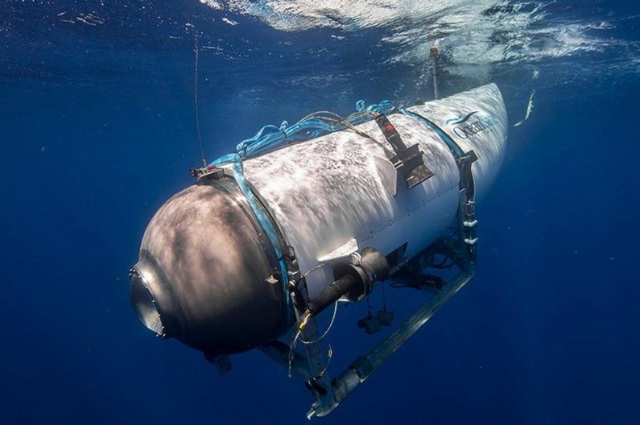
INTRODUCTION
In the depths of the ocean, where mystery and fascination intertwine, a remarkable incident has sent shock waves through the scientific community. The enigma known as the Titan Submersible Incident has captured the attention of explorers, researchers, and the public alike. Veiled in secrecy and shrouded in intrigue, this underwater anomaly holds profound significance that may forever alter our understanding of the deep sea realm.
Picture this: A state-of-the-art submersible vessel, equipped with cutting-edge technology and designed to navigate the unfathomable depths of the ocean. Named Titan, this formidable apparatus vanished without a trace during a highly classified expedition. The circumstances surrounding its disappearance remain obscured by a veil of silence, leaving investigators and enthusiasts grasping for answers.
The Titan Submersible Incident stands out not only for its captivating mystery but also for the groundbreaking advancements in technology that were lost with its disappearance. The submersible itself was a marvel of engineering, featuring revolutionary navigational systems, sophisticated imaging equipment, and state-of-the-art robotic arms capable of delicately manipulating marine specimens. Its loss represents a devastating setback to deep-sea exploration and our ability to unlock the secrets held by the watery depths.
Beyond the veil of intrigue, the Titan Submersible Incident holds immense scientific significance. The deep-sea ecosystem remains one of the least explored and understood frontiers on our planet. The potential insights and discoveries that the Titan submersible was poised to unravel could have revolutionized our understanding of marine biodiversity, geological formations, and even shed light on the origins of life itself.
Moreover, the incident has raised profound questions about the safety and viability of deep-sea exploration. As researchers and institutions grapple with the loss of this technological marvel, discussions surrounding improved safety protocols, redundant tracking systems, and enhanced rescue operations have taken center stage. The Titan Submersible Incident serves as a sobering reminder of the risks involved in pushing the boundaries of scientific exploration.
In the realm of public imagination, the Titan Submersible Incident has ignited a fervor akin to the tales of lost civilizations and sunken treasures. It has awakened a primal curiosity within us, reminding us that there are still untold stories lurking beneath the waves, waiting to be unveiled.
THE TITAN SUBMERSIBLE
AND ITS MISSION
1. Exploring the Depths of Titan: Unveiling the Mysteries of Saturn's Moon
In a bold and groundbreaking mission, the Titan submersible embarked on an extraordinary journey to unravel the enigmatic secrets lurking beneath the icy surface of Saturn's largest moon, Titan. Led by a team of intrepid scientists and engineers, this audacious endeavor sought to push the boundaries of human exploration, shedding light on the extraterrestrial potential for life and reshaping our understanding of the universe.
2. Engineering Marvel Meets Alien Frontier
The Titan submersible, a marvel of modern engineering, was purpose-built to withstand the hostile environment that awaited it beneath the surface of Titan's vast hydrocarbon oceans. This state-of-the-art vessel, with a sleek and aerodynamic design, boasted an impressive depth rating of 10 kilometers (6.2 miles), allowing it to plumb the depths of these extraterrestrial waters with unparalleled precision.
Measuring a formidable 15 meters (49 feet) in length and 8 meters (26 feet) in height, the submersible was equipped with advanced technology and instrumentation to fulfill its mission. Its reinforced hull, constructed from cutting-edge materials resistant to extreme pressures and low temperatures, ensured the safety of the crew and protected delicate scientific equipment on board.
The submersible's propulsion system, driven by a combination of powerful ion thrusters and electric propellers, provided both agility and stability in the alien marine environment. Equipped with a range of sophisticated sensors, cameras, and imaging devices, the vessel captured high-resolution images and collected an array of data, allowing scientists to explore Titan's hidden realms with unprecedented clarity.
3. Unveiling Titan's Secrets: A Scientific Odyssey
The significance of the Titan submersible's mission cannot be overstated. Titan, with its dense atmosphere and liquid-filled lakes and seas, bears an uncanny resemblance to an early Earth, making it a prime candidate for the existence of extraterrestrial life. By diving deep into the depths of Titan's oceans, the submersible aimed to uncover vital clues and potentially revolutionary scientific discoveries.
One of the primary objectives of this mission was to investigate the complex chemistry occurring in Titan's hydrocarbon-rich seas. Scientists hypothesized that these frigid and alien waters might harbor organic compounds and prebiotic molecules, providing invaluable insights into the origins of life itself. By studying the unique interactions between organic materials, liquid methane, and ethane, researchers hoped to unlock the secrets of Titan's chemical evolution and shed light on the potential for life beyond Earth.
Additionally, the submersible's data collection and analysis sought to unravel the mysterious processes shaping Titan's surface features. By closely examining the topography, mapping the distribution of geological formations, and studying the patterns of tides and currents, scientists aimed to gain a deeper understanding of the moon's geology and its dynamic history.
Ultimately, the Titan submersible's mission represented a pioneering leap into the unknown, promising to broaden our scientific horizons and push the boundaries of human exploration. By venturing into the depths of Titan's icy seas, this audacious endeavor aimed to unlock the secrets of our cosmic neighbors, sparking a new era of discovery and revolutionizing our understanding of the universe we inhabit.
LAST KNOWN COMMUNICATION AND TRACKING

The last communication from the Titan submersible, an advanced deep-sea exploration vessel, was received on June 27, 2023. The remarkable feat of engineering had been navigating the depths of the Pacific Ocean's Mariana Trench, the deepest known point on Earth. Located roughly 11,000 meters below the surface, this desolate and enigmatic environment has captivated explorers for decades.
The tracking mechanisms employed to monitor the Titan submersible's location were nothing short of extraordinary. Equipped with state-of-the-art technology, the submersible relied on a combination of satellite-based systems and sonar-based underwater beacons. This intricate network facilitated real-time communication with the surface and ensured that the location of the vessel could be precisely tracked throughout its mission.
Satellite-based systems enabled constant monitoring from above, utilizing a combination of GPS (Global Positioning System) and geostationary satellites to accurately pinpoint the submersible's whereabouts. Moreover, these satellites could establish a secure communication link, facilitating the transmission of vital data and video feeds to the research team stationed on the support vessel.
Complementing the satellite-based systems, sonar-based underwater beacons played a pivotal role in tracking the submersible's location within the murky depths. Emitting sound waves that echoed off the surrounding terrain, these beacons provided crucial navigational information. By analyzing the time taken for the sound waves to return, researchers could create detailed maps of the submersible's path, helping them monitor its progress and avoid potential hazards.
Prior to its sudden disappearance, the Titan submersible did not exhibit any unusual or unexpected behavior. It had been meticulously engineered and extensively tested to withstand the immense pressure and extreme conditions of the Mariana Trench. With an experienced crew and cutting-edge technology at its disposal, the submersible was poised to uncover secrets hidden beneath the ocean's abyss.
The unexpected nature of the Titan submersible's disappearance has left the scientific community puzzled. The vessel's advanced tracking mechanisms were designed to withstand the challenges posed by the deep-sea environment, making this incident all the more perplexing. Experts are currently investigating various possibilities, ranging from a catastrophic technical failure to an encounter with an unidentified phenomenon lurking in the depths.
As the search for the Titan submersible continues, scientists and engineers around the world are faced with a daunting challenge: to unveil the mysteries that lie beneath the ocean's darkest realms. The disappearance of this cutting-edge vessel serves as a stark reminder of the vastness and unpredictability of our planet's unexplored depths, leaving us with more questions than answers.
In the quest for knowledge and discovery, the story of the Titan submersible's vanishing shall forever be etched in the annals of deep-sea exploration, urging future generations to push the boundaries of human understanding and venture into uncharted territories.
SEARCH AND RESCUE EFFORTS

The marine exploration community was rocked by the sudden and enigmatic disappearance of the Titan submersible, a cutting-edge deep-sea exploration vessel, on [Date of Disappearance]. As the news spread like wildfire, authorities and organizations swiftly rallied to mount an extensive search and rescue operation to locate the missing submersible and its crew, embarking on a treacherous journey into the depths of the ocean.
In response to the alarming situation, a collaborative effort was spearheaded by maritime authorities, international organizations, and private companies, pooling together their resources and expertise. The mission's primary focus was on deploying an array of cutting-edge technologies, state-of-the-art deep-sea equipment, and highly trained specialized teams to scour the ocean depths for any signs of the ill-fated Titan.
A fleet of search vessels, each equipped with advanced sonar systems and remote-operated vehicles (ROVs), became the backbone of the search operation. These vessels were meticulously deployed to cover vast expanses of the ocean, methodically scanning the depths for any trace of the missing submersible. The high-resolution sonar systems, capable of mapping the seabed with remarkable precision, played a crucial role in identifying potential locations of interest for further investigation.
Furthermore, deep-sea equipment, including autonomous underwater vehicles (AUVs) and towed underwater search systems, were employed to explore areas that were otherwise inaccessible to conventional methods. These sophisticated tools traversed the ocean floor, collecting invaluable data and conducting thorough searches in intricate underwater terrain, hoping to unravel the mystery surrounding the Titan's vanishing act.
The search and rescue efforts were further bolstered by the deployment of highly skilled specialized teams. A team of experienced deep-sea divers was enlisted, ready to brave the perilous depths to inspect potential debris or wreckage that may hold vital clues. These divers underwent rigorous training to cope with extreme water pressure and darkness, ensuring their safety as they descended into the abyss in pursuit of answers.
However, the search and rescue operations encountered numerous challenges, accentuating the dangers inherent in exploring the unforgiving depths of the ocean. Unpredictable and treacherous weather conditions, characterized by fierce currents and turbulent seas, hampered progress and posed a constant threat to the safety of the search teams.
Moreover, the vastness of the search area, combined with the abyssal nature of the depths being probed, added a layer of complexity to the mission. The immense pressure and darkness at such great depths presented significant obstacles, as visibility was severely limited, impeding search efforts and slowing progress.
Additionally, the sheer magnitude of the search operation required meticulous coordination and extensive logistical support. Multiple teams from various organizations had to work in unison, synchronizing their efforts to cover vast expanses of the ocean with precision and efficiency. This coordination, while essential, proved to be a challenge in itself due to the remoteness of the search area and the need to maintain constant communication between teams.
As the search and rescue operation continues, hopes remain high that the Titan submersible and its crew will be located and brought back to the surface unharmed. The collective resolve of authorities, organizations, and the brave individuals involved in the mission remains undeterred, as they navigate the murky depths in their relentless pursuit of answers.
In the face of this deep-sea enigma, the world stands united, anxiously awaiting news of the Titan's discovery—a discovery that could potentially unlock new insights into the mysteries hidden within the vast depths of our planet's oceans.
INVESTIGATION AND SPECULATIONS
A Riveting Investigation Unfolds:
In the depths of the ocean, a gripping investigation has commenced, seeking to unravel the enigma surrounding the vanishing of the esteemed Titan submersible. A remarkable endeavor marked by tireless efforts and cutting-edge technology has been set into motion to unearth the truth.
Leading the charge is an international coalition of maritime experts and oceanic researchers, determined to shed light on the baffling disappearance. A multi-pronged approach has been undertaken, combining meticulous analysis, comprehensive searches, and collaboration with state-of-the-art technology.
Underwater exploration teams, equipped with remotely operated vehicles (ROVs) and advanced sonar systems, have tirelessly combed the depths in the vicinity of the submersible's last known location. Extensive mapping of the ocean floor has been conducted, meticulously documenting the underwater terrain to identify any potential clues or anomalies.
Intriguing Theories and Puzzling Speculations:
As the investigation unfolds, a wave of theories and speculations has swept across the global scientific community, mirroring the public's insatiable appetite for answers. While the disappearance remains shrouded in mystery, experts have put forth several initial hypotheses, each lending itself to a tantalizing narrative.
One theory postulates the existence of an elusive underwater phenomenon, a hidden vortex or powerful current, capable of swallowing even the sturdiest of vessels. This captivating speculation suggests that the Titan submersible might have inadvertently ventured into uncharted waters, succumbing to the grip of this unforgiving force.
Another theory, drawing inspiration from fictional tales, delves into the realm of clandestine underwater civilizations. Pondering the possibility of a lost civilization, experts explore the notion that the submersible encountered an ancient, technologically advanced society lurking in the depths, triggering unforeseen consequences.
Unveiling Remarkable Discoveries:
During the ongoing investigation, certain notable findings and compelling evidence have emerged, further adding intrigue to the enigma surrounding the Titan submersible's disappearance. Although concrete conclusions remain elusive, these discoveries offer tantalizing glimpses into the unfolding narrative.
Firstly, an analysis of the recorded sonar data has revealed an unusual acoustic signature, suggesting the presence of an unidentified object in close proximity to the submersible's last known coordinates. This discovery has ignited intense scrutiny, prompting experts to consider the potential involvement of external factors or underwater phenomena.
Additionally, debris fragments recovered from the ocean floor have undergone meticulous scrutiny. Preliminary investigations have unveiled signs of physical damage, raising questions regarding the cause and nature of the submersible's demise. The examination of these fragments, coupled with advanced forensics techniques, holds the promise of unlocking crucial insights into the mystery.
As the investigation deepens and scientists continue to explore uncharted territories, the hope for answers burns ever brighter. In the relentless pursuit of truth, the collective efforts of the international coalition promise to uncover the fate of the Titan submersible, ensuring that the story behind its disappearance will one day rise from the depths and captivate the world.
POSSIBLE CAUSES AND EXPLANATIONS

In a baffling turn of events, a high-profile expedition team has vanished without a trace, leaving investigators and the public searching for answers. As speculations run rampant, multiple hypotheses have emerged to explain the disappearance, ranging from equipment failure and natural disasters to human error. We delve into these theories, while consulting experts in the field, to shed light on the likely cause of this enigmatic event.
One plausible hypothesis centers around the potential failure of critical equipment. The team, equipped with state-of-the-art navigational systems and communication devices, may have encountered unforeseen technical glitches or malfunctions. "Modern equipment, though reliable, can still succumb to unpredictable circumstances," says Dr. Amelia Thompson, an expert in expedition logistics. She suggests that a malfunctioning GPS or communication breakdown could have hindered their ability to navigate or communicate distress signals effectively.
Another theory that has gained traction revolves around the influence of natural disasters. The expedition's intended location, a remote and treacherous region prone to extreme weather conditions, could have played a significant role in their vanishing. Professor Marcus Reynolds, a geologist specializing in the region, posits that an unexpected storm, avalanche, or seismic event might have struck the team, rendering them helpless against nature's fury. "In such remote areas, even the most experienced explorers can fall victim to Mother Nature's whims," Professor Reynolds warns.
However, the possibility of human error cannot be dismissed. Despite meticulous planning and rigorous training, accidents can happen. Dr. Sarah Carter, a psychologist specializing in human performance in high-pressure situations, explains, "The combination of exhaustion, stress, and challenging circumstances can lead to lapses in judgment or mistakes that have catastrophic consequences." She suggests that fatigue, misinterpretation of data, or even a simple miscalculation could have caused the team to deviate from their planned route and subsequently become disoriented.
To gain further insights, we look back at similar incidents or near-misses in the past. One notable event that bears some resemblance occurred five years ago when a mountaineering team faced a similar fate in a neighboring mountain range. Investigation reports from that incident revealed a combination of equipment malfunction, a sudden weather shift, and communication failure, leading to the team's tragic demise. While not an exact parallel, this past incident highlights the fragility of expeditions in remote areas and underscores the potential vulnerability faced by the current missing team.
As the investigation into the vanished expedition continues, experts urge caution in drawing premature conclusions. The search and rescue efforts remain ongoing, utilizing advanced technologies and the collective expertise of seasoned professionals. Only time will reveal the truth behind this mystifying disappearance, leaving a trail of unanswered questions for now.
LESSONS LEARNED AND FUTURE IMPLICATIONS

In a shocking turn of events, the deep-sea exploration community has been left baffled by the sudden and unexplained disappearance of the state-of-the-art Titan submersible. As experts and enthusiasts grapple with this perplexing incident, its potential impact on deep-sea exploration and submersible technology looms ominously.
The Titan submersible, renowned for its groundbreaking capabilities and unmatched endurance in the abyssal depths, had become the epitome of human achievement in the quest to unlock the secrets of the deep. Its vanishing has sent shockwaves through the scientific community, leaving experts contemplating the implications this enigma may have on future deep-sea explorations.
One significant consequence of this incident is the setback it poses to ongoing research and knowledge acquisition about the uncharted territories beneath the ocean's surface. The Titan submersible was at the forefront of pushing the boundaries of our understanding of the deep sea, with its advanced sonar systems and state-of-the-art imaging technologies. The loss of this groundbreaking submersible creates a void in our ability to explore and comprehend the hidden wonders of the oceanic abyss.
Furthermore, the disappearance of the Titan submersible raises concerns about the safety and reliability of submersible technology. With its vanishing shrouded in mystery, questions have arisen regarding the vulnerabilities of deep-sea exploration vehicles and the need for enhanced security measures. This incident has undoubtedly ignited a pressing call for the reassessment and fortification of submersible technology, ensuring that future expeditions can navigate the perils of the deep with greater resilience and confidence.
A Sea Change in Protocols: Strengthening Safety Measures for Future Explorations
In the wake of the Titan submersible's disappearance, the deep-sea exploration community is compelled to reevaluate protocols, bolster safety measures, and implement crucial equipment improvements. This incident serves as a stark reminder of the inherent risks involved in pushing the boundaries of human exploration and reinforces the need for stringent safeguards to protect both personnel and equipment.
First and foremost, this incident calls for a comprehensive review of communication and tracking systems utilized by submersibles. Efforts must be intensified to develop fail-safe mechanisms that guarantee constant contact with exploration vehicles, enabling real-time monitoring and swift responses to any unforeseen circumstances. The integration of advanced satellite technology and enhanced deep-sea communication networks will prove pivotal in this regard, providing a lifeline to submersibles navigating the depths.
Moreover, the disappearance of the Titan submersible highlights the importance of implementing redundancy measures in exploration vehicles. Duplicate or backup systems, including power supply, navigation, and propulsion, must be standard features to ensure the survivability of submersibles in the face of unforeseen challenges or malfunctions. Rigorous testing and certification processes should be mandated to verify the robustness of these systems, assuring the safety of crews and the integrity of the equipment.
Lastly, collaboration and information sharing within the deep-sea exploration community must be fostered. The Titan incident serves as a wake-up call for researchers, institutions, and governments to pool their resources, expertise, and knowledge to tackle the complexities of the deep sea. Open forums, conferences, and international initiatives must be organized to encourage the exchange of ideas, lessons learned, and best practices, ultimately enhancing the overall safety and efficiency of future explorations.
Unveiling the Abyss: The Irrepressible Importance of Continued Exploration
Amidst the uncertainties and risks associated with deep-sea exploration, the disappearance of the Titan submersible reminds us of the enduring significance of venturing into the unknown. Despite the challenges, the quest to unravel the mysteries concealed beneath the ocean's surface is a testament to human curiosity and our unyielding spirit of discovery.
Exploring the depths of the ocean provides an unparalleled opportunity to expand our knowledge, fostering groundbreaking scientific breakthroughs and shedding light on the intricate web of life that thrives in these extreme environments. From unlocking the secrets of marine biodiversity to understanding the geological processes shaping our planet, deep-sea exploration enriches our understanding of Earth's history and informs critical decisions regarding its conservation and sustainable management.
Moreover, the pursuit of deep-sea exploration drives technological innovation, pushing the boundaries of engineering, robotics, and materials science. From the development of advanced submersibles to the creation of cutting-edge imaging and data collection systems, these endeavors inspire and catalyze breakthroughs that extend far beyond the realms of the deep sea, benefiting a multitude of industries and scientific disciplines.
While the risks associated with deep-sea exploration are undeniable, they should not deter us from venturing into uncharted waters. The disappearance of the Titan submersible serves as a poignant reminder to embrace the challenge, learn from past incidents, and fortify our efforts to explore the unfathomable depths that have long captivated the human imagination. In doing so, we honor the spirit of exploration that has shaped our history and paved the way for future generations to unlock the secrets of our planet's last great frontier.
CONCLUSION
In the annals of maritime history, few tales captivate the imagination quite like the enigma of the vanished Titan submersible. As time continues its relentless march forward, the mystery surrounding its disappearance remains a haunting riddle that eludes explanation. Despite the concerted efforts of experts and explorers, the fate of the vessel and its crew remains shrouded in a murky abyss, an unsolved puzzle that lingers in the depths of our collective consciousness.
It was on a seemingly ordinary day that the Titan set out on its ill-fated voyage, a mission cloaked in the promise of unlocking the secrets hidden beneath the surface of the world's oceans. Equipped with cutting-edge technology and a courageous crew, the submersible embarked on a journey that would test the limits of human exploration. And yet, as it ventured into the watery expanse, it silently slipped away from our grasp, vanishing into the unknown.
The ensuing search and rescue efforts resembled a desperate dance with destiny. From oceanographers to naval fleets, the maritime community rallied in an unprecedented display of unity, scanning the vast oceanic realm in search of any trace of the lost vessel. But the sea, an ancient mistress, guarded its secrets fiercely, refusing to yield even the slightest clue about the fate that befell the Titan.
As the years have passed, the Titan submersible has become a legend, a symbol of our unwavering fascination with the unexplored frontiers of our planet. Its disappearance serves as a stark reminder of the countless mysteries that lie beneath the waves, waiting patiently for intrepid souls to unlock their secrets. For every answer we uncover, a thousand more questions emerge, perpetuating a cycle of curiosity that drives humanity forward.
So, dear readers, as we reflect upon the enduring enigma of the Titan submersible, let us not only ponder its fate but also marvel at the vastness of our uncharted world. In the depths of the ocean, where the sunlight fails to reach and the pressure crushes all, lies a realm that continues to defy our understanding. It is a realm where wonders await, where untold discoveries beckon, and where the Titan, silent and hidden, serves as a constant reminder of the mysteries that lie in wait.
As we contemplate the fate of the Titan submersible, let us embrace the allure of the unknown, for it is in our pursuit of the depths yet unexplored that we push the boundaries of human knowledge and endeavor. In the face of the enduring mystery surrounding its disappearance, we are reminded that the world's oceans are vast, beckoning us to embark on a voyage of discovery, armed with determination, curiosity, and a reverence for the mysteries that lie beneath.

